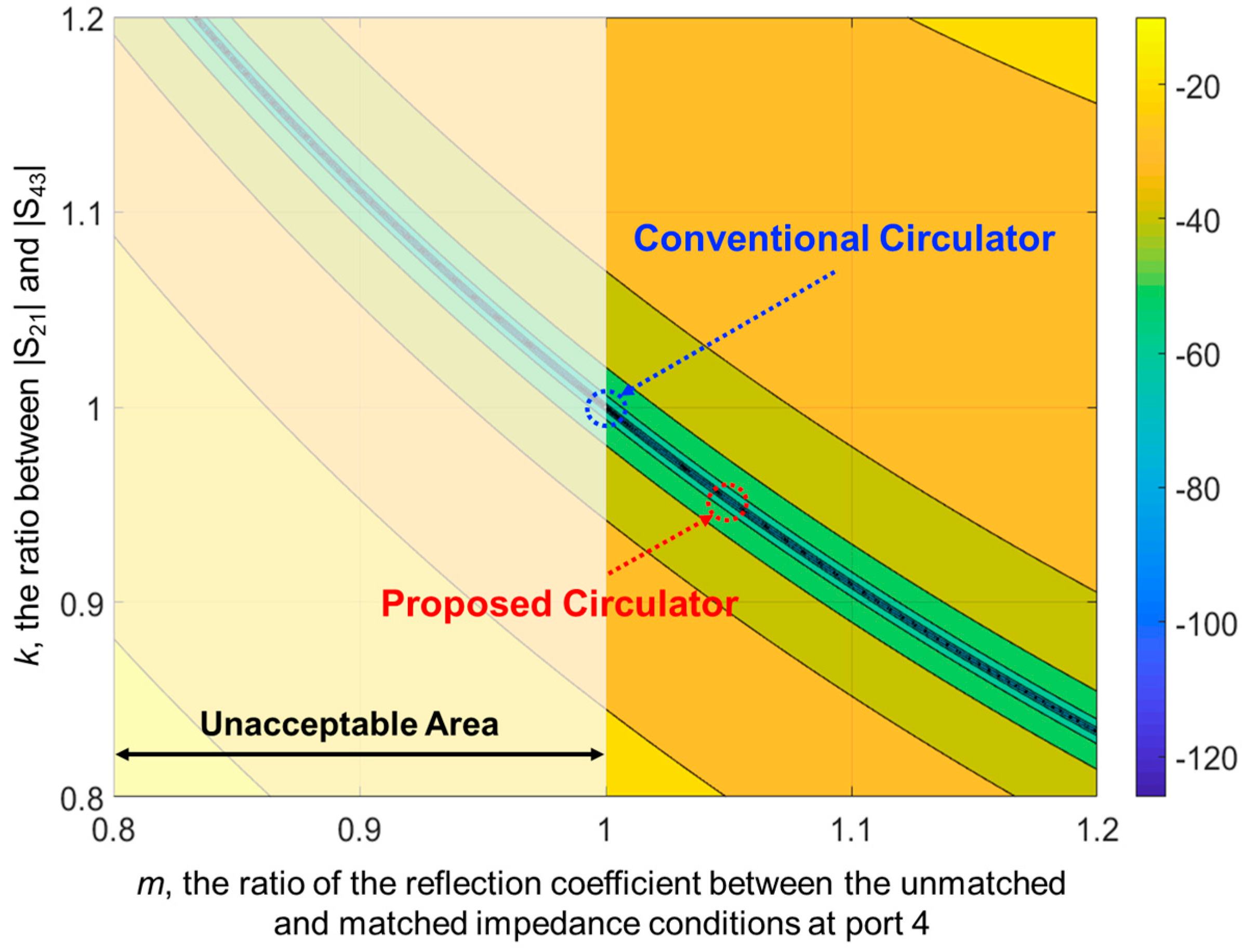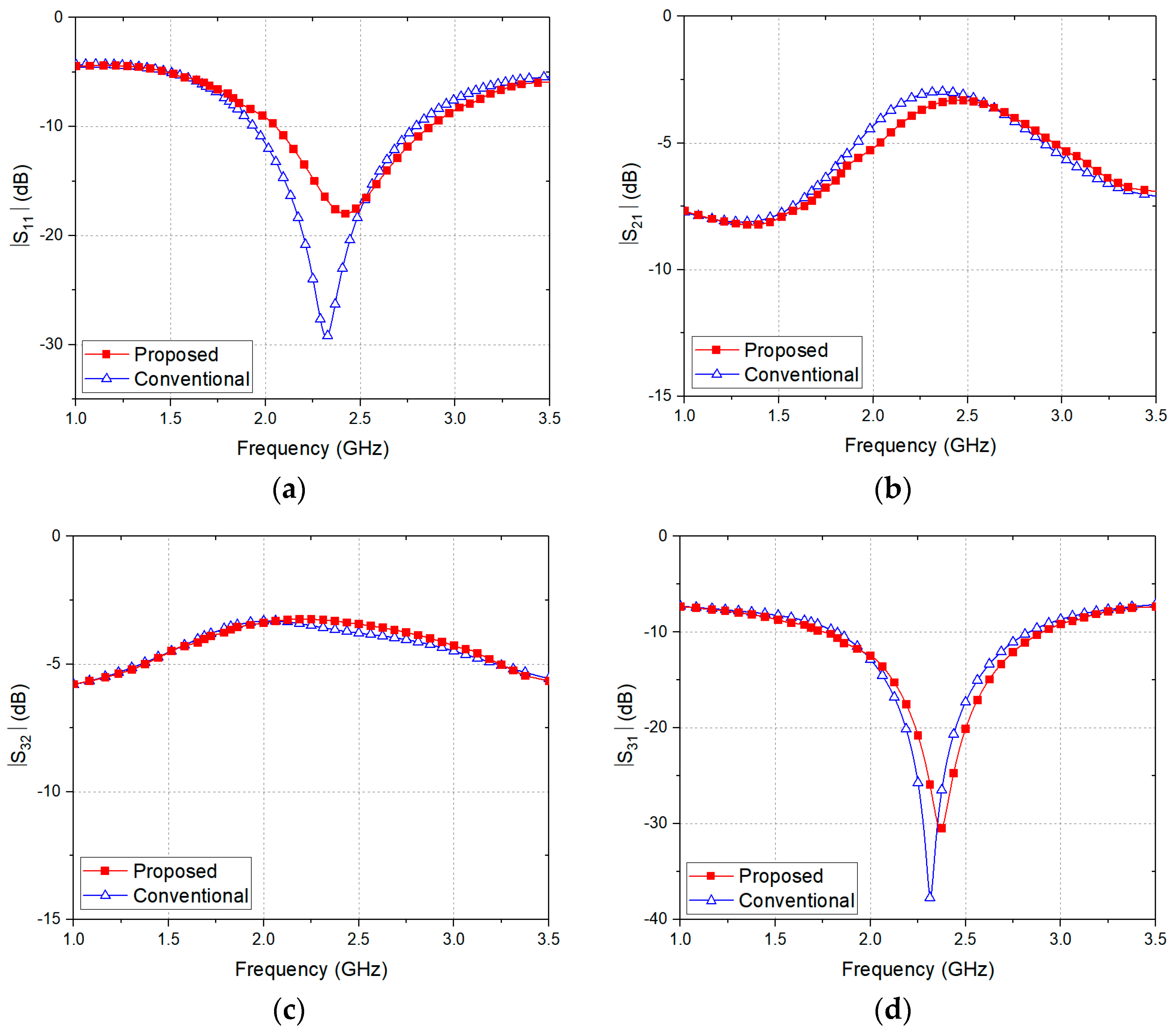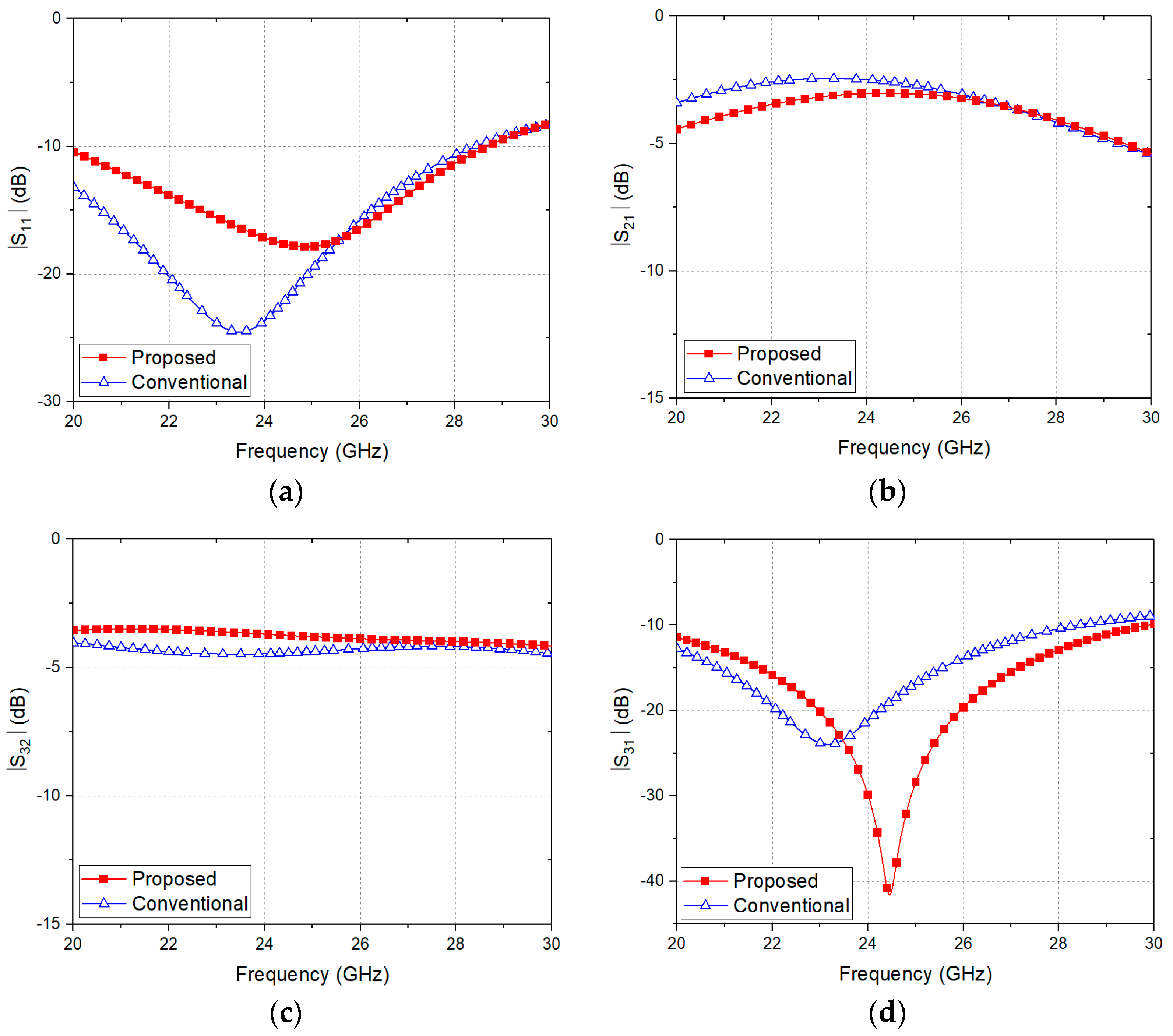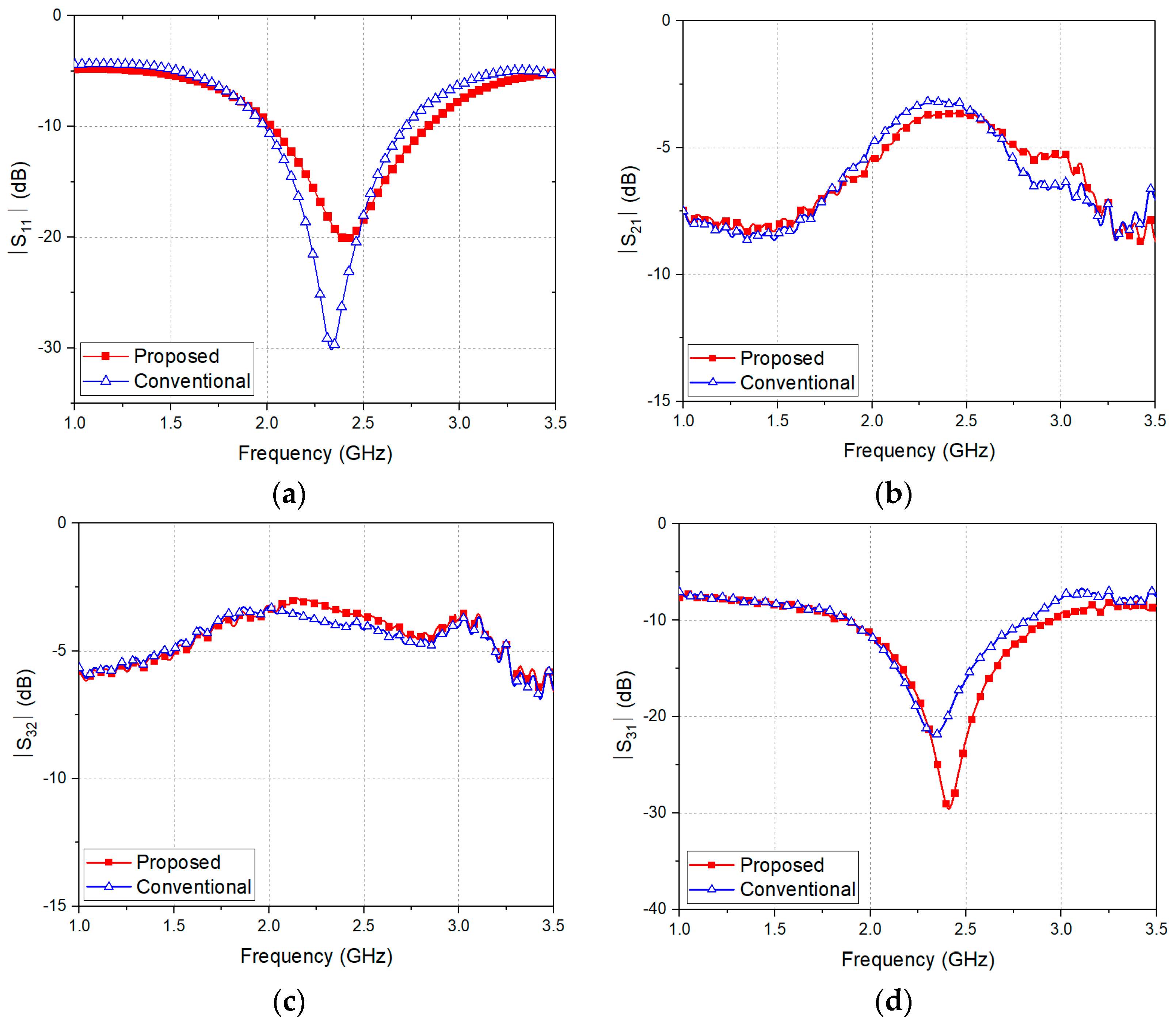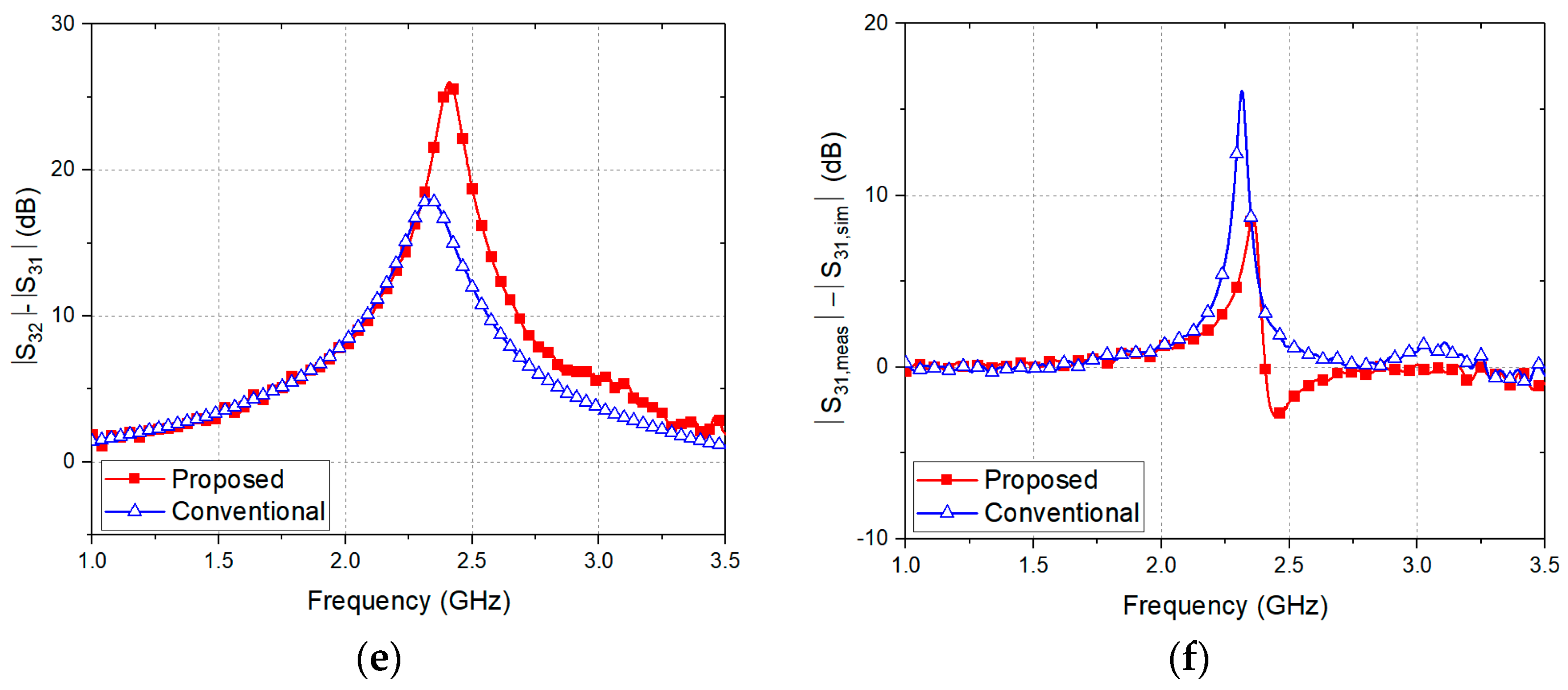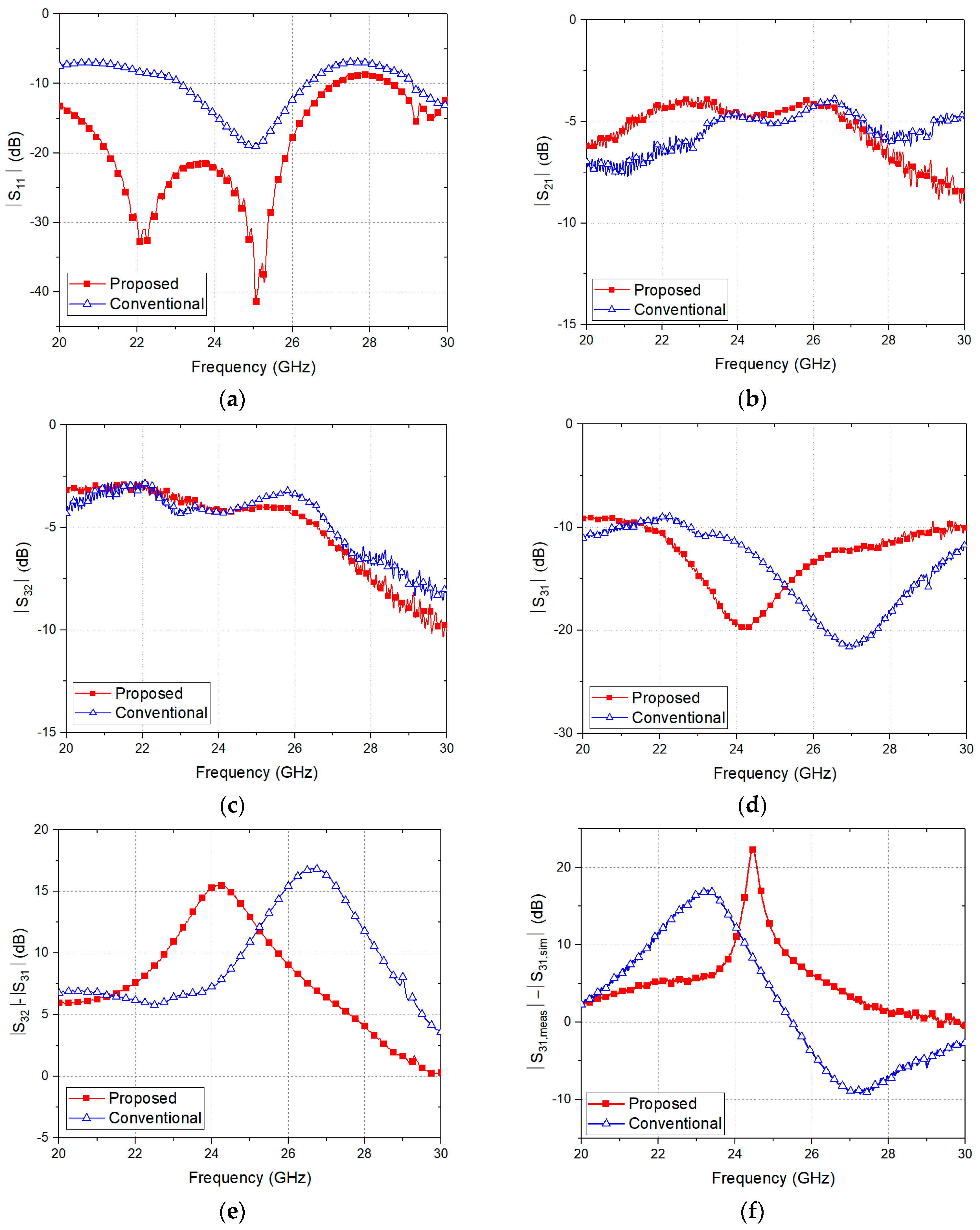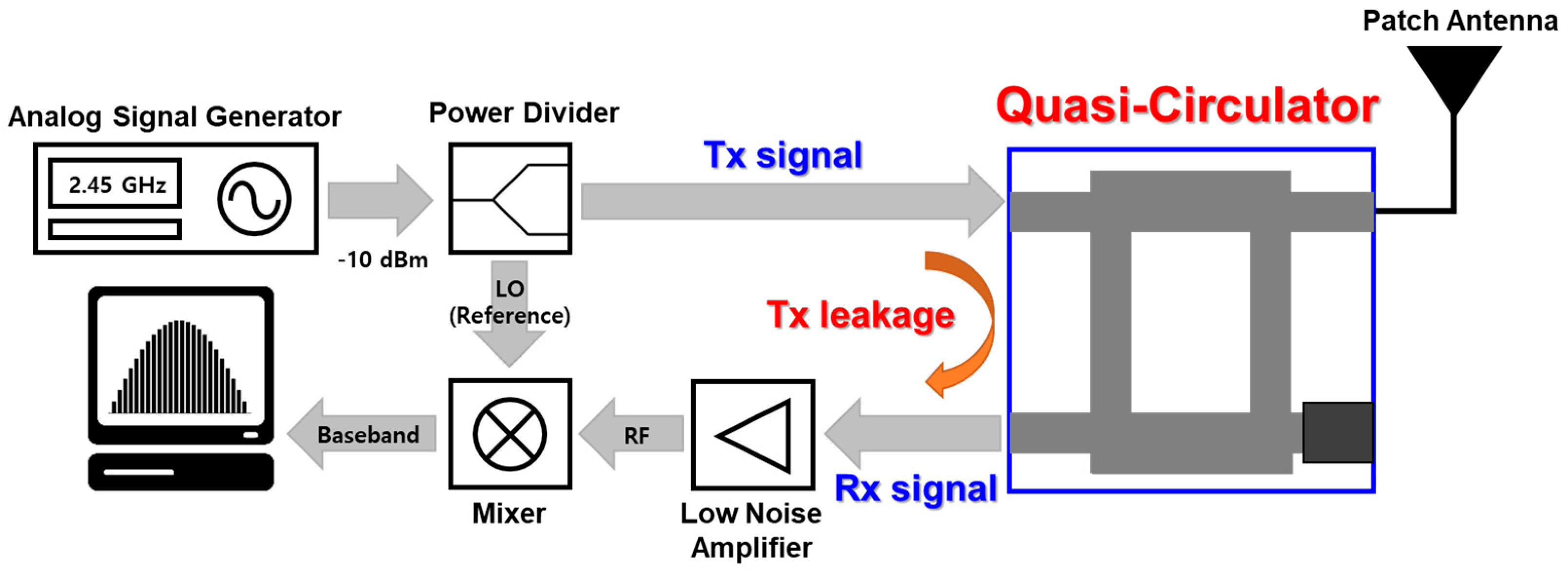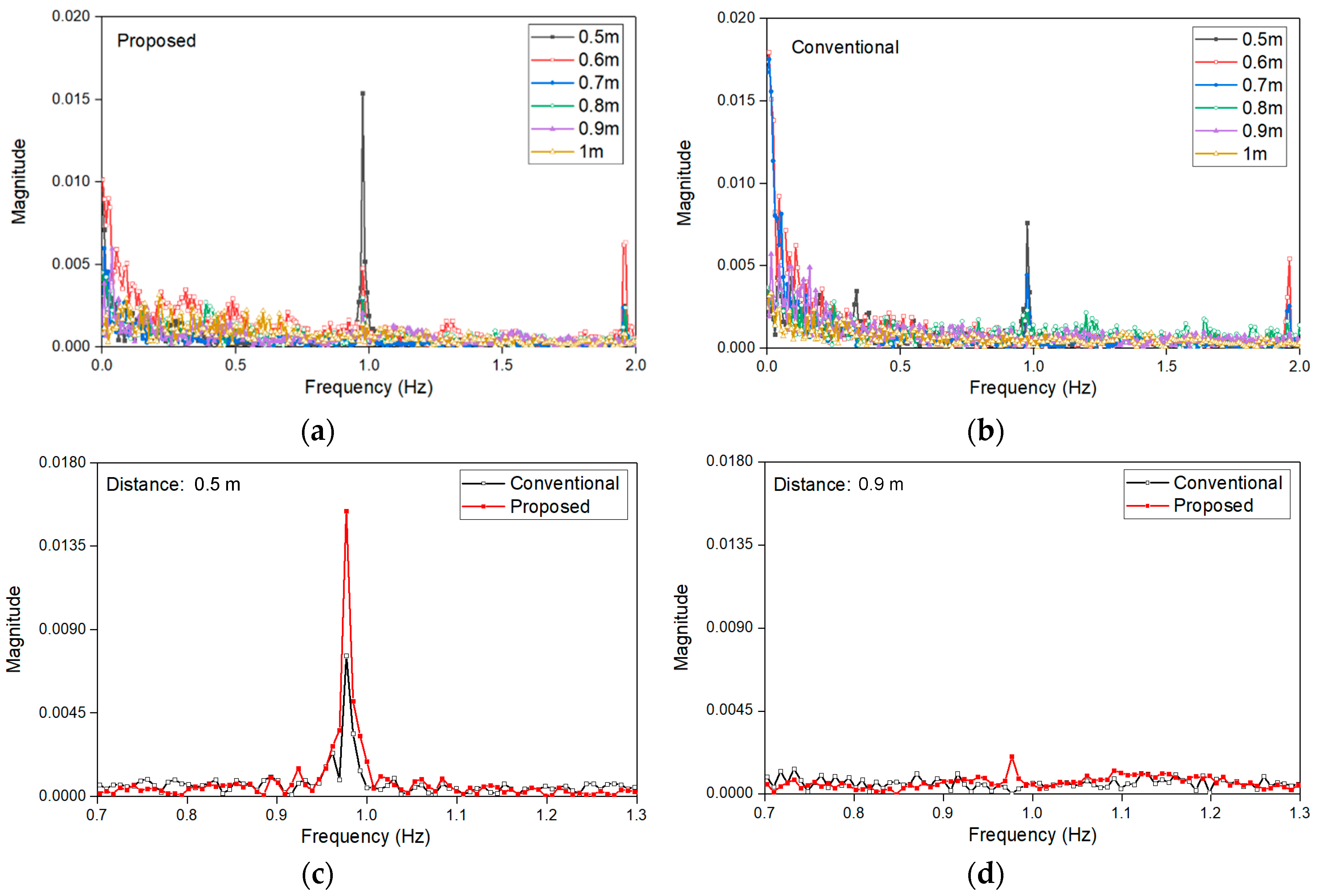1. Introduction
In electromagnetic-wave application systems such as radar sensors and wireless communication systems, the number and size of antennas should be considered in the implementation of the miniaturized module [
1,
2,
3,
4]. Since the antenna size depends on the operating frequency, it is more effective to reduce the number of antennas. The circulators can be used to reduce two antennas to one but it is not suitable for miniaturization because it is made of expensive directional materials or has disadvantages such as large size and heavyweight [
5,
6,
7]. The planar quasi-circulator is a useful component in separating transmitting (Tx) and receiving (Rx) signals in miniaturized monostatic radar and communication systems that use a single antenna to transmit and receive wireless signals [
4,
8,
9]. A branch-line coupler with a terminated port is conventionally used for a planar quasi-circulator because of its simple and low-cost design and its realization on a printed circuit board (PCB) [
4,
8,
9,
10,
11]. However, the low isolation of the branch-line coupler between the Tx and Rx paths, which lowers the Rx sensitivity or saturates the receiver, causes a receiver malfunction and limits the maximum detectable range [
4,
8,
9,
10,
11,
12,
13]. In previous studies, quasi-circulators using two branch-line couplers, a coupled-line directional coupler and a directional coupler with a flat coupling were developed as the planar quasi-circulator to improve the isolation [
9,
10,
11,
12]. The isolation between the Tx and Rx ports increased considerably in previous circulators; however, their size also increased because of the additional components. In addition, insertion losses at all ports increased when the Tx and Rx signals passed through those circulators. Previous studies to reduce the effect of the Tx leakage signals applied to a balanced topology for radar systems [
4,
14,
15,
16]. In this topology, it is necessary for Tx leakage cancellation to generate multiphase Tx signals. The topology also requires a symmetric structure consisting of several couplers and a power combiner, which may have a limit to reduce the size of the system.
While implementing the conventional quasi-circulator using the branch-line coupler, it is not easy to design the characteristics of the circulator accurately, especially the frequency at which the Tx leakage signal is minimized in the operating frequency band. In particular, since the line width of the transmission line cannot be neglected at the T-junction where the three transmission lines meet at one point, the conventional design parameters of the coupler should be modified. Because of the physical size of the T-junction, it is difficult to accurately design the length of the transmission line to the quarter-wavelength as in the electromagnetic-wave theory [
17,
18,
19]. The T-junction creates a discontinuous section of the electromagnetic wave propagation in the branch-line coupler, so it can also lead to the performance degradation and frequency shift of the coupler implemented using the simple analytic design method. In addition, the design difficulty increases significantly with shorter wavelengths resulting in increased characteristic errors in the component design with higher operating frequencies. The symmetrical implementation is an important characteristic in the conventional quasi-circulator because the parasitic components and the process variation in the PCB fabrication degrade the operating characteristics at the desired frequency or change the operating frequency which is different from the design [
20]. The uniformity of the signal pattern realized by the etching process can also be reduced in the fabrication process [
21].
In this paper, a quasi-circulator using an asymmetric branch-line coupler is proposed to improve the isolation between the Tx and Rx ports at the operating frequency based on a novel design methodology. The characteristic impedances of the quarter-wave transmission lines are designed with an asymmetric structure and the impedance at the unused port of the coupler is designed differently from the reference impedance to compensate for the asymmetric characteristic impedances of the transmission lines. Compared with the asymmetric branch-line couplers presented in previous studies [
22,
23], the asymmetric coupler proposed for the circulator in this work has three input/output ports fixed at the reference impedance of 50 Ω so that the conventional circulator component can be replaced as it is. In contrast to the previous studies, the proposed quasi-circulator adjusts the line widths of the transmission lines asymmetrically and compensates for the asymmetric characteristics using resistor(s) connected to port 4 of the coupler. The asymmetric coupler can be easily implemented because the desired characteristic impedance of the transmission line can be obtained by designing the line width in the microstrip structure. The characteristics due to the asymmetric transmission lines of the coupler are compensated by adjusting the impedance of the single port, which is simply implemented by high-frequency resistors. The proposed quasi-circulator has high Tx–Rx isolation at the operating frequency, while the frequency with high Tx–Rx isolation in the conventional circulator was shifted from the designed frequency. The insertion and return losses of the proposed quasi-circulator are similar to those of the conventional quasi-circulator. The remainder of the paper is organized as follows.
Section 2 describes the design methodology of the circulator using the asymmetric coupler. The implementation and design parameters of the circulators, operating at 2.45 GHz and 24.125 GHz, are detailed in
Section 3.
Section 4 provides the measured performances and comparison with conventional quasi-circulators using symmetric branch-line couplers. A conclusion is presented in
Section 5.
2. Design of the Quasi-Circulator Using the Asymmetric Coupler
The asymmetric branch-line coupler for the proposed circulator consists of four unbalanced quarter-wave transmission lines that have different characteristic impedances. The characteristic impedances are obtained by regulating the line width, defined as
Zi (i = 1–4), as shown in
Figure 1. In the conventional branch-line coupler, the characteristic impedances between the opposing transmission lines are the same, that is,
Z1 and
Z2 are equal to
Z3 and
Z4, respectively. Three terminals from ports 1 to 3 are connected to a transmitter, antenna and receiver, respectively, using the transmission lines with a reference characteristic impedance
Z50, which is 50 Ω. Port 4 is terminated using the certain impedance
ZISO, which is purposely unmatched with the reference impedance. The unmatched ratio at port 4 of the proposed asymmetric coupler is defined as the parameter
m, which is the ratio of the reflection coefficient between the unmatched and matched impedance conditions and is given as
where
S44|matched is the reflection coefficient at the matched condition and
S44 is the reflection coefficient at port 4 of the proposed branch-line coupler. Because the reflection coefficient at the matched port,
S44|matched, should ideally be 0,
m can be defined in the range from 1 at the matched condition to infinite at the mismatched condition. When the three ports of the proposed circulator are perfectly matched to the reference impedance 50 Ω, the S-parameter matrix of the proposed asymmetric branch-line coupler can be expressed (2) by the reciprocal property [
24] as follows:
Assuming that each port in the coupler is mutually independent [
24], the relationship between the transmitted signals to ports 3 and 4 can be obtained from (2) as follows:
Using the complex conjugate of the
S-parameters, (3) and (4) can be modified as
The first term of (6) and the second term of (7) are cancelled after subtracting (6) from (7) and (8) can be obtained as
Assuming that the coupler is lossless, the second and the third rows of (2) can be expressed as
and (8) can be modified to (11) using the relationship between (9) and (10) as
Substituting (5) into (11) for
S31 after modifying (5) for
S41*, the magnitude of the Tx leakage isolation |
S31| can be expressed as
where the parameter
K is the transmission ratio between the paths from ports 1 to 2 and from ports 3 to 4, which represents the effect of the different characteristic impedances. Considering that the reflection signal at port 4 cannot be neglected,
K can be expressed using the parameter
k, which represents the effect on the different impedances of the matched ports and the parameter
m as follows:
From (1) and (13), (12) can be expressed as
Figure 2 shows the variation in the magnitude of the Tx leakage signals in the branch-line coupler depending on
k and
m. The design equation
D to minimize the Tx leakage signals is derived from (15) as follows:
High Tx–Rx isolation can be obtained from (14), which shows that k can be compensated by adjusting m to improve the isolation between the Tx and Rx ports.
In the conventional circulator using the symmetric coupler, the parameters
k and
m of (16) are each designed to be 1. Although the conventional circulator theoretically satisfies (16), the leakage signals that cannot be ignored in the monostatic radar and the wireless communication systems remain in the actual implemented circulator. The transmission lines in the coupler must be precisely implemented with a quarter-wave length to obtain
k as 1. However, since the deviation of the line width of the transmission lines connected at one node cannot be neglected, realizing the quarter-wave transmission lines in the coupler implementation is difficult.
Figure 3 shows the difference between the ideal and actual interconnections of the transmission lines in the conventional branch-line coupler. Theoretically, the lengths and widths of all the transmission lines in the branch-line coupler are designed to the quarter-wavelength
L1 of the operating frequency and the widths
W1 and
W2 by the characteristic impedances of the lines. However, the lines cannot meet at the single point in the implementation of the coupler and the T-junction should be used to connect the lines as shown in
Figure 3b. The line length of the coupler cannot be the same as the theoretical quarter-wavelength
L1 because of the physical size of the T-junction. The design inaccuracy increases in the implementation of the coupler since the design that approximates the length to
L1′ or
L1″ in
Figure 3b considering the dimension of the junction cannot be regarded as the accurate design methodology. The size of the junction is almost frequency-independent since it is mainly designed by the widths
W1 and
W2 depending on the characteristics of the substrate. The design error by the junction increases in the implementation as the operating frequency increases because the quarter-wavelength decreases but the size of the junction is almost constant depending on the increase in frequency. This produces the non-ideal characteristics in the symmetric branch-line coupler and the value of
k in the implemented coupler becomes a different parameter with the design value of 1. The multiple reflections and transmissions, the substrate and propagation losses and other parasitic effects should be considered to accurately design the value of
k when implementing the branch-line coupler. However, the complexity of the design can increase. The characteristics of the coupler are especially sensitive to the change in the physical size of the T-junction due to fabrication error. This is the main reason why it is difficult to accurately design the branch-line coupler on the PCB in the millimeter-wave frequency bands. The characteristic changes caused by the T-junction can be modified by optimizing the theoretical design parameters using the electromagnetic wave simulation but there is a problem that the optimization process is required for each design every time. For improving the isolation by reducing the effect of the T-junction, the proposed quasi-circulator using the asymmetric branch-line coupler increases the degree of design freedom by using the specific
k parameter and the
m parameter to compensate for the
k parameter. When the
k parameter is set to a value that is excessively smaller than 1, the width of the transmission line becomes thinner in the realization on the PCB because of the increase in the characteristic impedance of the line. The excessively thin width of the line can cause performance degradation because of the process tolerance for the fabrication of the PCB. In the proposed quasi-circulator, the parameters
k and
m of (16) are 0.947 and 1.053, respectively.
3. Implementation of the Proposed and Conventional Quasi-Circulators
The conventional quasi-circulator using the branch-line coupler consists of four quarter-wave transmission lines with characteristic impedances
Z1 and
Z3 of 35.4 Ω and
Z2 and
Z4 of 50 Ω, as shown in
Figure 1, respectively [
24]. Port 4 of the conventional circulator is terminated with the reference impedance
Z50. Based on the design parameters
k and
m in
Section 2, the characteristic impedances
Z1,
Z2,
Z3 and
Z4 of the transmission line and the termination impedance
ZISO are obtained in the proposed circulator using the asymmetric coupler. To reduce the size of the T-junction, the characteristic impedances
Z1 and
Z4 in the proposed circulator are designed to 40 Ω and 60 Ω, respectively. The value of
k in the circulator is obtained by using
Z2 of 45 Ω and
Z3 of 35 Ω. Unbalanced impedances of the transmission lines are compensated by using
ZISO of 45 Ω to achieve the desired value of
m at port 4. All circulators were simulated using a Keysight Advanced Design Systems Momentum electromagnetic-wave (EM) simulator considering the dielectric constants, loss tangents and thicknesses of PCBs.
3.1. Quasi-Circulators for 2.45 GHz
The asymmetric and symmetric couplers, operating at a 2.45 GHz frequency band, were fabricated on an FR4 PCB with a dielectric constant of 4.3 of 39 mm × 30 mm and 35 mm × 30 mm and a thickness of 1 mm, as shown in
Figure 4. In the conventional circulator using the symmetric coupler, the widths
W1 and
W2 of the transmission lines with the characteristic impedances 35.4 Ω and 50 Ω were designed to be 3.3 mm and 1.9 mm, respectively. Although the quarter-wavelength at 2.45 GHz is 14.8 mm on the FR4 PCB, the lengths of the transmission lines in
Figure 4a were designed by including the size of the junction as 16 mm, 17.9 mm, 16 mm and 17.3 mm, respectively. Using the designed characteristic impedances
Z1,
Z2,
Z3 and
Z4, the widths of the transmission lines in the proposed circulator were designed to be 2.6 mm, 2.2 mm, 3.3 mm and 1.3 mm, respectively. Because the size of the T-junction was changed by the designed impedances, the lengths of the transmission lines in
Figure 4b were modified to be 16 mm, 17.8 mm, 16 mm and 16.9 mm, respectively. The design accuracy can be increased in the proposed circulator because the lengths of the proposed circulator were reduced as compared with the lengths of the conventional circulator. The termination resistance at port 4 was realized using a single 45 Ω resistor with the size of 10 mm × 5 mm made by Murata Manufacturing Co., Ltd. (Nagaokakyo, Kyoto, Japan).
Figure 5 shows the simulation results for the quasi-circulators. The operating frequency of the conventional circulator is lower than the design frequency of 2.45 GHz but the frequency of the proposed circulator is almost the same as the design frequency. In addition, the proposed circulator shows |
S21| of −3.31 dB and |
S32| of −3.39 dB at 2.45 GHz, which are similar to each other, whereas the conventional circulator obtains |
S21| of −3.05 dB and |
S32| of −3.74 dB at this frequency.
3.2. Quasi-Circulators for 24.125 GHz
As shown in
Figure 6, the directional couplers operating at the 24.125 GHz frequency band were realized on an RO3003 PCB with a dielectric constant of 3.0 of 17 mm × 13 mm and a thickness of 10 mil. The losses caused by the length of the transmission line equally occurred in both of two couplers because the total size of the two PCBs is the same as each other. The widths of the conventional quasi-circulator were designed to be 1.0 mm and 0.6 mm for the transmission lines with the characteristic impedance of 35 Ω and 50 Ω, respectively. The quarter-wavelength at 24.125 GHz is 1.8 mm on the RO3003 PCB but the lengths of the transmission lines in the conventional circulator were implemented as 1.4 mm, 2.0 mm, 1.9 mm and 2.4 mm, respectively. The widths of the lines designed in the 24.125 GHz proposed quasi-circulator are 0.8 mm, 0.7 mm, 1.0 mm and 0.5 mm, respectively. The line lengths of the proposed circulator were individually designed to be 1.4 mm, 2.0 mm, 1.9 mm and 2.2 mm, respectively. As in the design of the 2.45 GHz circulators, the length on the left side was also reduced by 0.2 mm compared to the length of the conventional one. The resistance of 45 Ω at port 4 was implemented using high-frequency resistors of 50 Ω and 500 Ω in parallel, which were made by Vishay Intertechnology, Inc. (Malvern, PA, USA).
The simulation results in
Figure 7 show that the proposed quasi-circulator designed at 24.125 GHz but the conventional quasi-circulator designed at a frequency lower than the desired frequency. These are similar characteristics to the simulation results of the 2.45 GHz quasi-circulators. The insertion losses in the Tx and Rx paths are well balanced in the simulation results of the proposed circulator. Note that a conventional circulator could be well optimized to have accurate characteristics at the operating frequency but it takes a long time to design because the physical lengths and line widths of the transmission lines must be determined by parametric optimization. The simulation results considering the physical size of the T-junction show that the proposed circulator can be exactly designed at the desired operating frequency without the complicated optimization process.

